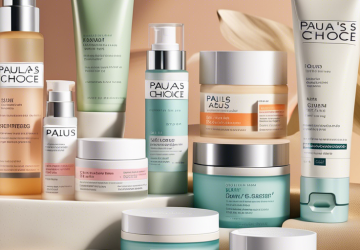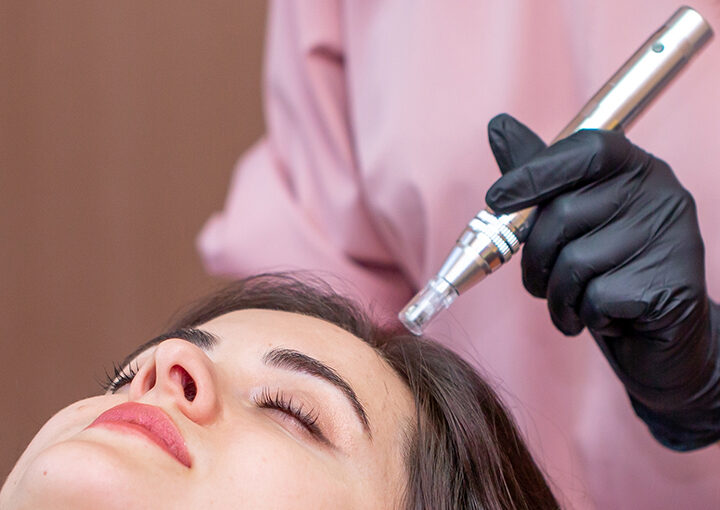[ad_1]
Cosmetology is witnessing newer trends that continue to provide long-term solutions to people with hair loss. Microblading your hairline is one such procedure that stimulates hair growth. It works on a similar principle as eyebrow microblading, where a manual device deposits pigments on the scalp that mimic the actual hair follicles. So, if you are looking for ways to boost hair growth effectively, this procedure may help. Read on to learn more about hairline microblading, its benefits, costs, and potential risks.
What Is Microblading Hairline?
Microblading hairline is a procedure that uses a thin blade with tiny needles to add pigment to the surface of the scalp. It covers thinning hair by forming strokes on the scalp that mimic natural hair. It is a semi-permanent solution that makes your tresses look healthier, thicker, and voluminous.
This treatment is beneficial for people with alopecia, thinning hair, and pattern baldness. Scroll down to understand how this treatment helps with hair loss.
Benefits Of Hairline Microblading
- Helps Your Hair Look Denser And Fuller: Microblading mimics the appearance of actual hair by adding body to the mane and giving it a dense, fuller look. This may make people feel more confident about themselves.
- Helps People Deal Better With Underlying Conditions: People with androgenetic alopeciai XA genetically predetermined disorder characterized by permanent scalp hair loss in both men and women. , madarosisi XA condition that leads to loss of eyebrows and eyelashes caused by a bacterial, fungal, or viral infection. , andtrichotillomaniai XA mental disorder characterized by a recurrent, uncontrollable, irresistible urge to pull out body hair. , who experience severe hair loss, may benefit from this procedure because it creates the illusion of thicker hair (1), (2), (3), (4).
- Is A Customized Treatment Option: Hairline microblading does not adhere to a one-size-fits-all approach. It gives a personalized treatment as per the person’s needs. They use specially-formulated composite inks to complement an individual’s skin tone (1), (5).
While this procedure has important benefits, one must also be aware of its drawbacks before going for it.
Downsides Of Hairline Microblading
- The Pigment Fades Over Time: Hairline microblading is a semi-permanent process that requires regular touch-ups since the pigment may fade after a year.
- May Cause Skin Irritation: Microblading can triggerallergic dermatitisi XA response or reaction to an allergen or irritant that causes swelling or itchy rashes on the skin. , which can result in discomfort and skin inflammation similarly seen after an eyebrow microblading procedure (6).
- May Cause Vitiligo: Studies suggest that microblading might lead to vitiligo or white patches on the skin(6).
- May Cause Difficulty In Pigmentation Removal: You can undergo a laser treatment to remove pigmentation. However, it may cause severe discomfort(7).Consult a dermatologist before doing so.
- Is A Time-Consuming Process: Microblading your hairline can take hours and might take almost a month to heal completely.
- Your Hair May Change Color: The ink component mostly contains ingredients like iron oxide. Prolonged exposure to the sun can turn it reddish. Similarly, prolonged exposure to the sun can turn synthetic inks blackish-gray (5).
So, should you opt for this procedure? The following section can help you decide.
Who Would Require Hairline Microblading?
Hairline microblading is ideal for:
- Those with a wider forehead, their hairline peeking backward, thin hair, or hair fall.
- Those who want to accentuate their facial features and reduce asymmetry by altering the hairline to suit their face shape.
While microblading hairline is more successful than other scalp restoration surgeries, it is better if some individuals avoid it.
Who Should Not Opt For Hairline Microblading?
Anecdotal evidence suggests that individuals with the following issues should avoid this procedure.
- Those allergic or hypersensitive to tattoo ink.
- Those with skin disorders like eczema or psoriasisi XAn autoimmune disorder where the build-up of cells causes scaly, itchy patches and rashes on the skin. .
- Those with oily skin, as they might not get the desired results due to excessive sebum production on the skin (which might make the ink look blurry).
- Those who are pregnant or lactating, as the ink applied to the surface may seep into the bloodstream and cause complications.
Understanding how the procedure works also helps you make a decision about it. Check the next section.
How Does The Treatment Work?
Following are the steps involved in a microblading hairline procedure:
- The area to be operated on and the adjoining areas are cleaned.
- Anesthesia or numbing, topical cream is applied to the skin.
- The skin is stretched in three opposing directions to facilitate the process.
- A microblading pen dipped in ink deposits pigments by forming strokes on the scalp.
- The pigment is smudged on the scalp and wiped off after 5 minutes of normal saline.
- An antibiotic ointment is applied to the affected area.
StyleCraze Says
Get rid of excess oil from your scalp and hairline by using a chemical-free blotting paper. Those with normal skin need to do it 3 times a day, while those with oily skin need to do it 6 times a day.
Preparation before every treatment is key for better results. Scroll down to learn how you need to prepare yourself before going for a hairline microblading procedure.
How To Prepare For Hairline Microblading?
- Refrain from taking caffeine, alcohol, aspirin, or any other blood thinners at least a week before the procedure.
- Refrain from using harsh or abrasive scrubs or products containing glycolic acid or retinol at least 5 days before the procedure.
- Ensure your scalp is clean and dry on the day of the treatment. No gel or moisturizers to be used.
StyleCraze Says
Wash your hair on the day or day before the procedure. Wait for seven days before washing your hair to maintain the effectiveness of the treatment.
Let us now get a better understanding of how to take care of your hair and speed up the healing process. Continue reading.
Hairline Microblading Aftercare
Keep these tips in mind after completing your microblading hairline procedure:
- Avoid touching the operated area or letting it come in contact with water for 48 hours.
- Avoid wearing makeup or using anti-aging creams for at least a week.
- Do not cleanse your face with soap or a facewash for a week. Instead, use water to clean the skin.
- Do not indulge in hair or facial steaming for at least 6 weeks after the treatment.
- Get a touch-up 2-3 weeks after the procedure or once your skin starts peeling.
- Avoid prolonged exposure to the sun to prevent color changes.
Hairline microblading is reasonably priced. It’s worth every bit of your money when compared to the cost of other hair replacement procedures, wigs, creams, or foams. Read on to learn more.
Cost Of Hairline Microblading
The price solely depends on the severity of the problem and the size of the area to be operated on. The average cost may range between $1000 to $3000.
Most people often confuse hairline microblading with a hair transplant. The two procedures have differences, and we will explore the same in the next section.
Hairline Microblading Vs. Hair Transplant: Key Comparisons
| Hairline Microblading | Hair Transplant |
|---|---|
| Mimics the natural texture of the hair by adding pigment to the scalp. | Inserts new hair into the hair follicles. |
| A semi-permanent process that requires frequent touch-ups as the ink fades after some time. | A permanent process that doesn’t need touch-ups. |
| An easier and affordable procedure that costs between $1000 to $3000. | An expensive procedure that costs up to $15,000. |
Final Words
Hairline microblading is a procedure where ink is deposited on the scalp to mimic the appearance of natural hair. This procedure is beneficial for people with hair loss and its effects can last up to 18 months. However, people with skin disorders and ink allergies should avoid this procedure. Factors like skin type, amount of sun exposure, and frequency of hair washes might impact the longevity of the results. Always consult a dermatologist to understand whether the procedure is right for you before opting for it.
Frequently Asked Questions
Is hair microblading painful?
No, hair microblading is not painful as the hairline is numbed with a skin-numbing cream. Also, the tiny needles used in microblading don’t penetrate the skin. Instead, they gently scratch the surface to form strokes.
What is an alternative to microblading?
Scalp micropigmentation is an alternative to microblading. It uses smaller needles to deposit pigment on the scalp for a pin-pricked, shaved head-like effect.
How many times can you get microblading done?
Microblading hairline can last up to 12-18 months depending on your lifestyle, skin type, and sun exposure. Hence, you can get the procedure done once every one to one and a half years.
How do you sleep after microblading?
Sleep on your back to avoid putting any pressure on your scalp and pulling the hair.
Key Takeaways
- Hairline microblading deposits pigment on the scalp to mimic the appearance of natural hair.
- This process is beneficial for people who experience hair loss from androgenetic alopecia or madarosis.
- People with eczema, psoriasis, or ink allergy should avoid this procedure.
Sources
Related
[ad_2]








